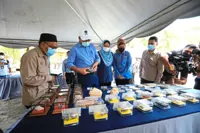The ministry’s NMITP Plan 2021-2030 aims to grow the Malaysian mineral industry into a complete value chain for the next 10 years.
THANKS to the Earth’s geological formation millions of years ago, today Malaysia is blessed with various mineral resources – all of which have contributed to the country’s economic growth.
These resources are valuable and hold the potential of being developed in accordance with the principles of sustainability, to ensure the long term availability of these resources.
Since the decline in tin mining, the country’s mineral industry has been sluggish for some type of minerals, due to limited investments for exploration into new mineral resources.
Furthermore, impact from external factors – such as land use change, urban development and the rapid development of other
sectors, namely in manufacturing and the services sectors – has
rendered the mineral industry less attractive.
However, when assessing its importance, all parties should realise that mineral is the fundamental sector, one that supports other strategic economic sectors.
Without mineral production, sectors such as construction, manufacturing, electrical and electronics, telecommunications, logistics and more would experience setbacks in their own activities.
So instead of relying on imported mineral raw materials, industries should first seek local available sources that have not been previously explored.
Responsible, sustainable planning
As interest in mineral exploration picks up, the focus on environmental impacts and the effects on natural habitats should always be maintained.
Preservation has always been a government agenda, as evidenced by restrictions on mineral explorations and mining activities within forest reserve areas.
This includes environmentally sensitive areas (KSAS), water catchment areas, groundwater resource areas and wildlife habitat areas.
Such restrictions safeguard against disrupting the ecosystem and the implicit risks pertaining to disasters, life support value, treasure value and heritage value of the area.
Currently, developed countries use various geophysical technologies in mining and quarrying, ranging from 3D imaging, virtual reality, augmented reality, geographical information systems, autonomous vehicles to drones and other state-of-the-art technologies.
Prospectors who are keen on developing the country’s mineral industry in the future should consider employing hi-tech devices to gather data on mineral distribution, land use and more efficient mine operation.
Similarly, a comprehensive database platform needs to be developed – one that includes traceability application of mineral resources for the purpose of monitoring and controlling trade.
To realign the country’s mineral industry as one that is fast-growing and developed, the Government has proposed the long-term National Mineral Industry Transformation Plan 2021-2030 (MIT 2021-2030 Plan).
This will be implemented throughout the 12th and 13th Malaysia Plans aimed at enhancing the mineral industry’s development and management.
The emphasis will be on value-added creation, sustainable operations and supporting industries creation, as well as deploying the latest technology available in the Industrial Revolution 4.0 era.
The main aim of this plan is the “significant contribution of the mineral industry to economic growth” and will be the main focus for achievement.
It will be guided by the mission of “developing the mineral industry across the entire value chain based on the principles of sustainability.”
The plan itself is developed based on five main pillars, which cover governance and legislation, mineral industry value chain development, mineral resource mapping and inventory, technology application and innovation, as well as human capital development.
Driven targets
The MIT 2021-2030 Plan aims at growing the Malaysian mineral industry into a complete ecosystem throughout the entire value chain for the next 10 years, especially involving the strategic minerals.
To achieve this, the Government has set key target indicators, as implementation of the plan progresses.
These include increasing the contribution of mining and quarrying sub-sectors to the country’s GDP from 0.7% to 1% by 2030, establishing a Malaysian Mineral Industry Development Board, reducing trade imbalances, and developing the entire mineral industry value chain – from upstream to downstream.
Based on the preliminary mapping, the country’s mineral resources are estimated to reach RM4.11tril.
When used optimally, these resources should provide multiple returns to the nation’s economy and avoid sterilisation of the country’s valuable mineral resources.
In addition, Research and Development will be carried out to develop processing techniques for some strategic minerals to add value to the raw minerals.
These include tin ore, silica sand, kaolin, bauxite and non-radioactive rare earth elements (NR-REE).
These minerals should be prioritised for domestic use to reduce the country’s dependence on imported mineral resources.
Concerted effort
The Government also aims to develop these mineral resources more efficiently with investment from within and outside the country, to bring advanced and environment-friendly technology.
With this investment, it is possible to realise certain areas as targeted regions or clusters designated specifically for mineral industry.
On top of recycling mine waste that may still be of value, the MIT 2021-2030 Plan also introduces the concept of “circular economy” to mining – to maximise available mineral resources use.
The concept of “urban mining”, the extraction of minerals from waste materials in households, electronic components and so on, will also be explored.
In fact, the Government has developed standard operating procedures (SOPs) that need to be adhered by all relevant parties.
This reflects the Government’s efforts in not only focusing on
economic development, but also concentrating on environmental sustainability aspects and the well-being of its citizens, in order to ensure the industry’s sustainability.
Each initiative that has been set out in the MIT 2021-2030 Plan also takes into account the role that should be played by the state governments in developing the mineral industry.
In this regard, the Government will ensure that the targets set for 2021 to 2030 are successfully achieved in accordance with the action plan and timeline.
Datuk Seri Dr Shamsul Anuar Haji Nasarah is Minister of Energy and Natural Resources.







